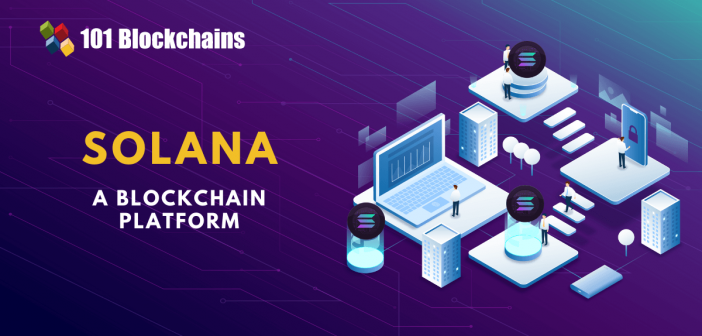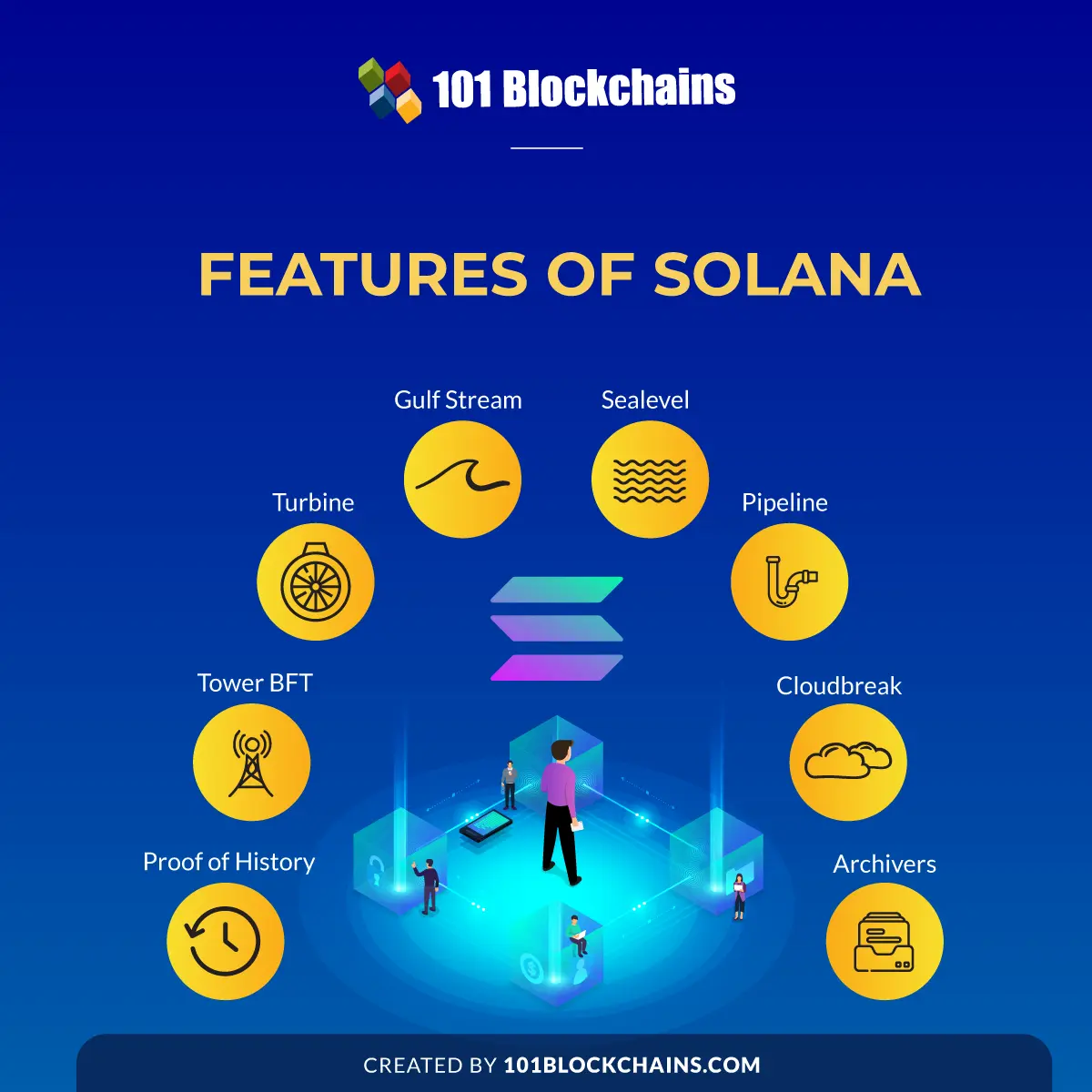Learn how blockchain truly works, master key definitions, and uncover what makes smart contracts so "smart." Dive into the fundamentals, gain valuable insights, and start your blockchain journey today!

- Guides
Georgia Weston
- on February 07, 2022
What Is Solana And How Does It Work?
Did you recently come across the term, Solana? Learn more in detail about Solana and how it works.
Cryptocurrencies marked the beginning of a completely new era for finance and technology in general. The crypto sector takes away intermediaries from the design of conventional financial services by introducing peer-to-peer transactions. However, popular cryptocurrencies such as Bitcoin and Ethereum have prominent limitations in terms of scalability. Why? It is impossible to scale up the time required for reaching a consensus on a specific order of transactions.
Therefore, alternatives like Solana or SOL have emerged as promising solutions for such problems. Now, you might wonder about how the new cryptocurrency could solve problems that the crypto pioneers could not. Let us take a deep dive into an introduction to the Solana blockchain and find more about its working. The following discussion will also help you uncover the new and unique features introduced with the SOL crypto token.
Build your identity as a certified blockchain expert with 101 Blockchains’ Blockchain Certifications designed to provide enhanced career prospects.
Rationale for Solana
Why did we need another cryptocurrency when we already have so many of them? The answer to this question can help us find out the reasons for developing the SOL blockchain platform as a competitor to Ethereum and Bitcoin. In the case of cryptocurrencies, the order of transactions would rarely coincide with the order of blocks on the blockchain.
When users start a transaction on the crypto platform, it goes directly into an unconfirmed pool. Subsequently, the confirmed and verified transactions are added to the blockchain, thereby leading to the creation of multiple branches of blocks and double-spending. Solana helps in resolving these issues through automation of the transaction ordering process associated with blockchain networks.
Enroll now in the Solana Development Course to understand the workings of the Anchor framework, Solana Program Library, and Solana tokens.
Understand Its Definition
So, what is the new SOL network everybody is talking about in the crypto space? Solana is basically just another blockchain network tailored for developing cryptocurrencies such as Bitcoin and Ethereum. It is a better alternative to Ethereum, especially for its faster speed of transactions. As a matter of fact, the new blockchain platform could easily perform almost 50,000 transactions per second. SOL can easily incorporate multiple traits in the existing network, including application development or SOL token mining, within a few seconds. The cryptocurrency has rightly earned the credential of being a competitor to Ethereum.
The Solana blockchain provides assurance for speed, security, and censorship resistance. Based on the RUST programming language, SOL delivers a formidable base for safeguarding all transactions. In addition, the use of Proof of History also enables it to offer a highly scalable and efficient network.
Start your blockchain journey Now with the Blockchains Fundamentals Course
History of Solana
The background of Solana also plays an important role in defining how it finds a better position than other cryptocurrencies. Antony Yakovenko established the network in 2017 with his experience as a software engineer and work in compression algorithms. Antony worked in collaboration with Eric Williams and Greg Fitzgerald to create a new process of crypto transactions to address conventional throughput problems in Bitcoin and Ethereum.
The founders of the new blockchain platform aimed at developing a trustless and distributed crypto protocol with ease for better scalability. As of now, the team includes experienced professionals from top organizations such as Apple, Google, Intel, Dropbox, Microsoft, Twitter, Qualcomm, and many others. Furthermore, the impact of the Solana blockchain has successfully garnered many investors, such as Multicoin Capital, Abstract Ventures, Foundation Capital, CMCC Global, and many more.
Working of Solana Network
The history of Solana shows how it has been tailored as a faster alternative to conventional cryptocurrencies. If you want to find out answers to “what is Solana used for?” in detail, then you need to reflect on its working. Once you develop a clear impression of how SOL works, you can easily understand its applications. From a broader perspective, the SOL network is just a public blockchain protocol optimized for better scalability.
Apart from developing cryptocurrencies, the SOL blockchain also enables developers to create scalable dApps through the network. As a result, the decentralized applications could easily find their way around some of the formidable setbacks for performance. The Solana blockchain also brings a Proof of History consensus system, which empowers automatically ordered transactions. It serves as an internal clock for the platform alongside the Proof of Stake consensus mechanism for the security of the network.
According to Solana coin market cap evaluation, as of now, its market capitalization is around $30.79 billion. On top of it, the token registered 24hr trading volume growth of 20.88%. At present, it is the highest-performing permissionless blockchain platform worldwide with 200 physically unique nodes. Proof of History helps in creating historical records for proving the occurrence of an event at a specific point in time. The algorithm is actually a high-frequency Verifiable Delay Function, which requires a certain quantity of sequential steps for evaluation.
Transactions or events undergoing evaluation would receive a unique hash and a counter, which you can verify publicly and effectively. The counter helps in finding the time of occurrence for each transaction or event. It would work exactly like a cryptographic time-stamp, and each node features a cryptographic clock for tracking the time and order of events on the network. As a result, Solana can ensure better efficiency.
Features of Solana

Please include attribution to 101blockchains.com with this graphic. <a href='https://101blockchains.com/blockchain-infographics/'> <img src='https://101blockchains.com/wp-content/uploads/2022/02/Features-of-Solana.png' alt='Features of Solana='0' /> </a>
The most crucial element which defines the perfect answers for “what is Solana used for?” would refer to the features of the crypto platform. As a highly innovative blockchain, the SOL network brings the value of eight unique features such as the following.
-
Proof of History
Proof of History is the pre-consensus clock for the Solana blockchain and helps in network reach consensus on time and sequence of transactions. The network develops a cryptographically secure time throughout the network. With the help of Proof of History, you can get a unique output suitable for public verification. As a result, the nodes don’t have to work in coordination with the whole network. Since nodes would coordinate with the consensus clock, the transaction overhead reduces considerably.
-
Tower BFT
Tower BFT is a Practical Byzantine Fault Toleration or PBFT consensus algorithm tailored for Proof of History networks. It is a critical element in understanding “what is Solana used for?” with references to its practical implications. Tower BFT capitalizes on the benefits of the synchronized clock in Proof of History. Therefore, it can achieve consensus without incurring any massive transaction latency or messaging overheads.
Start your blockchain journey Now with the Enterprise Blockchains Fundamentals
-
Turbine
The next fundamental highlight in the Solana network refers to Turbine, the block propagation protocol on the network. Turbine protocol supports easier data transmission to the blockchain nodes. The Turbine protocol achieves efficient data transmission by breaking data into smaller packets. As a result, Solana blockchain could easily address the concerns pertaining to bandwidth alongside increasing the overall capacity for faster transaction settlement.
-
Gulf Stream
Another functional feature in the design of the SOL blockchain platform refers to Gulf Stream. It is practically suitable for addressing a significant role in carrying transaction caching forward to the edge of the network. As a result, validators could ensure the execution of transactions way ahead of time, alongside reducing confirmation time. Gulf Stream also facilitates faster leader switching alongside reduced memory pressure on validators from different unconfirmed transaction pools. If you look closely, the Gulf Stream protocol is responsible for ensuring 50,000 transactions per second.
-
Sealevel
Sealevel is also a prominent highlight in the innovative features of the Solana crypto network. It is practically a hyper-parallelized transaction processing engine used for scaling horizontally across various SSDs and GPUs. The SOL network can enjoy a better runtime with efficiency alongside allowing concurrent transactions on the same state blockchains.
-
Pipeline
Pipeline in the SOL network is the transaction processing unit that works for optimizing validation. The process involves assigning a stream of input data to different hardware components. As a result, the mechanism can support faster validation and replication of transaction information throughout different nodes in the network.
-
Cloudbreak
Cloudbreak is the horizontally-scaled accounts database of the Solana blockchain. It helps in achieving the desired levels of scalability on the SOL network. Basically a data structure, Cloudbreak is an ideal pick for concurrent read and write operations across the network.
-
Archivers
Archivers are also an innovative feature that expands the scope of answers for “what is Solana used for?” in many interesting ways. You can use Archivers as the distributed ledger storage where you can offload data from validators to a network of nodes. The nodes or Archivers are lightweight and subject to audits for ensuring data integrity.
The final and most crucial highlight is the SOL token or the native currency in the ecosystem. It can serve as the means of payment for running on-chain transactions or validating transactions. In addition, the SOL token also serves an important role in facilitating micropayments such as lamports.
Start learning Blockchain with World’s first Blockchain Career Paths with quality resources tailored by industry experts Now!
Bottom Line
On a final note, you can notice how Solana is a promising alternative to conventional cryptocurrencies such as Ethereum and Bitcoin. It brings a unique blend of Proof of History and Proof of Stake consensus to reduce the time required for transaction processing and validation. On the other hand, the SOL network also features innovative components designed to further its vision and objectives. The existing market capitalization of the Solana blockchain, alongside the partners associated with it, presents favorable prospects for its future. Learn more about cryptocurrencies and practical use cases of the SOL blockchain network in detail right now.
*Disclaimer: The article should not be taken as, and is not intended to provide any investment advice. Claims made in this article do not constitute investment advice and should not be taken as such. 101 Blockchains shall not be responsible for any loss sustained by any person who relies on this article. Do your own research!






